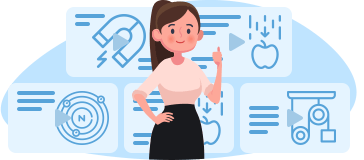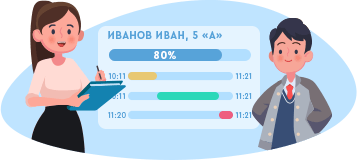— Hello, friends! My name is Martin Green. My friend’s name is James Wilson.
— Welcome to our grammar lesson!
— Today we will tell you one interesting story about two ants.
— Hello, my name is Present Simple.
— And my name is Present Continuous.
— We used to be friends, but then my dad told me to stop seeing my friend Present Continuous. He said: «Both of you are so different. You cannot be friends! »
— Since then we live on the different sides of the river.
— We don’t know what we can do to become friends again!
— James, let’s help the ants to become friends again!
— Sure, Martin! What should we start with?
— I think we need to find out whether Present Simple and Present Continuous differ from each other or not.
— Let’s learn when we can use these two tenses. We will start with Present Simple.
One
We use Present Simple when we want to describe actions, which happen regularly.
For example:
Mike always brushes his teeth in the morning.
(Mike does this action every day)
Two
We can use Present Simple to talk about a timetable or fixed plans in the future.
For example:
My lessons begin at twelve o’clock tomorrow.
(We are talking about a fixed school timetable)
Three
We use Present Simple when we talk about general truth.
For example:
Animals need food for a living.
or Five plus five is ten.
Four
We also use this tense, when we want to describe a situation, which is thought to be more or less permanent.
For example:
She works in a hospital.
or I don’t eat fish.
Five
We use Present Simple to give instructions or directions. In this case we usually use the words: first, and, then.
For example:
First, take a knife. Then cut the onion and put it in the frying pan.
(We are giving instructions how to cook properly.)
Six
We also use this tense to talk about a series of actions. We can use it in stories or to comment on sports events.
For example:
She throws the stick to the dog; the dog runs after it and catches it.
(We are telling the story about the dog)
Seven
This tense is also used to talk about the future and after the following words: before, after, when, if etc.
For example:
I will go for a walk with him, when I have time.
Eight
We use this tense to form conditional sentences type 0 and type I.
For example:
If the cat Nikki catches the fish, it will eat it.
(This is conditional sentence type I)
Now we know when we can use Present Simple. Let’s learn when we can use Present Continuous.
One
We use this tense to describe things that are happening at this moment.
For instance: Sally is feeding pets at this moment.
(The action is happening at the moment of speaking and it’s not finished.)
Two
We use Present Continuous to describe temporary situations, even if the actions are not happening right now.
For instance: Molly is staying with her dad in Egypt for a month. (She might not be staying with him right now.)
Three
This tense can be used to talk about new habits. In these cases, we usually use the following words: these days and at the moment.
For instance: Bryan is sleeping a lot these days. (He didn’t use to do this.)
Four
We can also use this tense when we talk about habits that are not regular, but they repeat very often. In these cases we use the following words: always, forever and constantly.
For instance: Mike is always laughing so contagious.
Five
We also use this tense when we talk about habits that irritate somebody.
For instance: Dan is always missing the bus. (This action is happening all the time.)
Six
We use Present Continuous to talk about planned events, which will happen in the future.
For instance: Andy is visiting his aunt tomorrow at nine o’clock. (Andy and his aunt have already planned their meeting.)
Now we know, when we can use Present Continuous, but you must know that we don’t use Present Continuous with the words that are related to:
Senses
For example: To touch, To taste, To smell, To feel, To look.
Mental states
For example: To forget, To realize, To be aware, To suppose, To imagine.
Emotions
For example: To love, To hate, To like, To dislike, To fear.
Desires
For example: To wish, To prefer, To want, To mind, To plan.
Measurements
For example: To size, To contain, To include, To measure, To scale.
Opinion
For example: To think, To suppose, To guess, To expect, To assume.
and Other
such as: To be, To seem, To have (when it means to possess), To look (when it means to resemble)
— Martin, now we know that Present Simple and Present Continuous are used in different situations. What else can we do to help the ants?
— Let’s find out, how we form these tenses. We can’t give up. The ants count on us!
— Yes, you’re right!
Present Simple
To form positive sentences we put the subject in first place, then we use the first form of the verb (infinitive without particle to). For example: watch, swim, run, jump.
And for the third person singular we use ending s or es, which we add to the verb. For example: watches, swims, runs, jumps.

To form negative sentences we put the subject in first place, then we use the auxiliary verb do plus not, the short form is don’t and after that we put the first form of the verb. For example: don’t watch, don’t swim, don’t run, don’t jump.
And for the third person singular we use the auxiliary verb does plus not, the short form is doesn’t and then we put the first form of the verb. For example: doesn’t watch, doesn’t swim, doesn’t run, doesn’t jump.

To form interrogative sentences or questions we put the auxiliary verb do in first place, then we put the subject and after that, we use the first form of the verb. For example: Do you watch? Do you swim? Do we run? Do they jump?
And for the third person singular we use the auxiliary verb does, then we put the subject and after that, we use the first form of the verb. For example: Does he watch? Does he swim? Does she run? Does it jump?

Let’s look at the example.
— Hi, dad. What do we have for dinner?
— Hi, Bobby. We have fried potatoes with eggs.
— Oh, I don’t like eggs. Why do you always cook something I prefer not to eat?
— Come on, Bobby. You need to wait only a week. When your mom comes back from her business trip, she will cook something delicious for you!
In this example we used:
positive
negative
and interrogative sentences.
Present Continuous
When we form positive sentences, we put the subject in first place, then we use verb to be in the Present Simple tense. The verb to be has three forms in this tense: am, is, are. We use am with the pronoun I, is with he, she, it and are with you, we, they. After that we put the main verb with the –ing suffix. For example: I am playing the guitar. She is reading a book. We are cleaning the house.

When we form negative sentences, we put the subject in first place, then we use one of three forms of the verb to be with not: am not, is not, are not. Their short forms are: ‘m not, isn’t and aren’t. After that we put the main verb with the –ing suffix. For example: I’m not playing the guitar. She isn’t reading a book. We aren’t cleaning the house.

When we form questions, we put one of three forms of the verb to be: am, is, are - in first place, then we put the subject. After that we put the main verb with the –ing suffix. For example: Am I playing the guitar? Is she reading a book? Are we cleaning the house?

Look at the example.
— Hello, Ron. Guess, what I’m doing right now!
— OK, are you listening to music?
— No! I’m not listening to music!
— Are you watching TV?
— No, I’m not watching TV!
— I don’t know then.
— Oh, it’s very simple! I’m talking to you on the phone!
In this example we also used:
positive
negative
and interrogative sentences.
— Oh no, Present Simple and Present Continuous are formed in different ways. We still can’t find what they have in common.
— Let’s compare the time markers of these two tenses.
In the Present Simple Tense we use the following markers: Always, Often, Every month/ year, Usually, Rarely, Seldom, Never.
In the Present Continuous Tense – Now, Right now, At the moment, Listen!, Look!, Still, These days, Next week/ month/ year, In the nearest future.
— Oh, Martin! We couldn’t find, what Present Simple and Present Continuous have in common! They will never become friends again.
— Wait! I think I know the answer!
— Really? Tell me, please!
— Why do you think we call them PRESENT Simple and PRESENT Continuous?
— That's right! We call them like that, because they are both used to talk about actions in the PRESENT.
— Dad, did you hear that? Present Continuous and I are not completely different! It means that we can be friends!
— All right! You can become friends again. I’m so sorry, I was mistaken.
— Thank you, Martin and James! We will never forget about your help!
— Hooray! Now we will be friends forever!
— You're welcome!
— We finally managed to find what two friends have in common!
— Now show us that you understood all the information about Present Simple and Present Continuous.
Open the brackets using the Present Simple or Present Continuous Tenses.
Let’s check the right answers.
1. Where is Lucy? — She is washing the dishes now.
2. Is Andy watching his favorite film “The sound of music” at this moment?
3. Peter always listens to his eldest brother Ben.
4. Listen! We are not fighting with him.
The following sentences.
Let’s check.
5. Do you usually swim in the lake or in the swimming pool?
6. Charlie doesn’t like wearing green and yellow clothes. They are too bright for her.
7. My parents are visiting my aunt tomorrow in the evening.
8. Our interview starts at 4 p.m. tomorrow. Don’t be late! At 4:30 I have another candidate.
— Now you know the difference between Present Simple and Present Continuous. We also discussed what they have in common.
— That’s all for today!
— See you soon.

 Получите свидетельство
Получите свидетельство Вход
Вход




 2
2 2219
2219



Здравствуйте, Жанна. Свободный доступ на время карантина открыт на 2-е полугодие. Пользователями, которые приобрели комплект доступны все видео 1-го и 2-го полугодия.
К сожалению, никак не получается открыть и посмотреть видеурок, по-прежнему предлагается купить его. Где же заявленный свободный доступ ко всем видеоурокам на время карантина?!